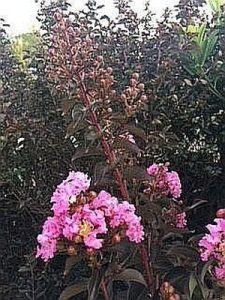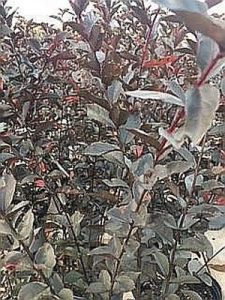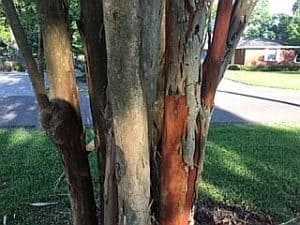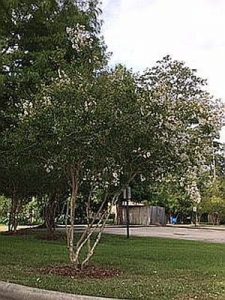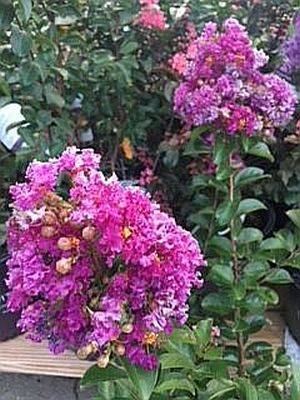
Crape Myrtle – Lagerstroemia indica
Crape myrtles are among the most striking plants for our area. Often times referred to as the “Lilac of the South.” Showy summer flowers, attractive bark, and (in many cases) brilliant fall color make them year-round garden performers. Long, cool autumns yield the best leaf display. Crape Myrtle is a native of China. It is a member of loose-strife family, Lythraceae. Small round dark green leaves turn yellow, orange, red, lavender, purple-red. Modern cultivars come in a variety of sizes. Tall, over 15 feet, Medium, 8-15 feet, semi-dwarf 3 to 8 feet, dwarf, less than 5 feet and Miniature crape myrtles, (18-24 inches) which were developed by horticulturist David Chopin who holds a BA and MS from LSU, Baton Rouge. The crape myrtle was the official flower of the 1984 World’s Fair in New Orleans. This long-lived plant has been grown in New Orleans since before 1837. Most crape myrtles in gardens are selections of L. indica or hybrids of that species with L. fauriei. The latter species has attracted much notice for its hardiness and exceptionally showy bark. Queen’s crepe myrtle, L. speciosa, grows only in the Tropical South.
Plant crape myrtles from October to March in full sun. Plants will grow and perform poorly in shade. Plant in well-drained soil keeping soil evenly moist until established. Prefer pH 5.0 to 6.5. Fertilize in late winter using a general-purpose fertilizer like 12-12-12. Bees, butterflies, hummingbirds and other beneficial insects are attracted to crape myrtles for nectar and pollen.
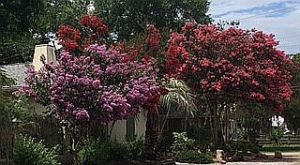
Do not do any pruning for the first couple of years after planting. After that, remove any suckers that form at the base of the trunks. Over the next five or ten years, gradually remove lower limbs as the trees grow taller to raise the canopy to the desired height. Maintain about one-half trunk to one-half leafy canopy. Don’t remove too many lower branches each year. When pruning a crape myrtle, don’t chop your large crape myrtles down to ugly stubs each spring like some uninformed homeowners do. This ruins the natural form and encourages the growth of spindly, whip-like branches that are too weak to hold up the flowers. They look like dangly snakes hanging off the branches to me. To reduce a crape myrtle’s height, use hand pruners or loppers to shorten the topmost branches by 2–3 feet in late winter, always cutting back to a side branch or bud. Crape myrtles bloom in summer on new wood and should be pruned in winter or early spring. During the growing season, clip off spent flowers to promote a second, lighter bloom. Also prune dwarf forms periodically throughout the growing season, removing spent blossoms and thinning out small, twiggy growth. You don’t have to remove spent blossoms on tall trees that are difficult to reach.
L. fauriei can grow to 20–30 feet tall and wide, with erect habit and outward-arching branches. Light green leaves to 4 inches long and 2 inches wide turn yellow in fall. This copper-barked crape myrtle has especially handsome bark: the smooth gray outer bark flakes away to reveal glossy cinnamon brown bark beneath. Small white flowers are borne in 2 to 4 inch-long clusters in early summer; often blooms again in late summer. Resistant to mildew and best known as a parent of hardy, mildew-resistant hybrids with L. indica, though it is handsome in its own right. ‘Fantasy’, with even showier bark than the species, has a vase form?narrow below, spreading above. ‘Kiowa’ has outstanding cinnamon-colored bark.
L. indica, the premier summer-flowering tree of the South, tolerates heat, humidity, drought; does well in most soils as long as they are well drained. May be frozen to the ground in severe winters in the Upper South but will re-sprout. Variable in size (some forms are dwarf shrubs, others large shrubs or small trees) and habit (spreading or upright). Dark green leaves are 1 to 2 1/2 inches long and somewhat narrower, usually tinted red when new; they often turn brilliant orange or red in fall. Crinkled, crepe-papery, 1 to 1 1/2 inch-wide flowers in white or shades of pink, red, or purple are carried in dense clusters. Trained as a tree, it develops an attractive trunk and branch pattern. Smooth gray or light brown bark peels off to reveal smooth, pinkish inner bark; winter trunk and branches seem polished.
Mildew, sooty mold, aphids and leaf spot diseases can be a problem for crape myrtles. Spray with fungicide before plants bloom or grow mildew-resistant hybrids of L. indica and L. fauriei. Almost all selections with names of Native American tribes, such as ‘Hopi’, ‘Miami’, and ‘Zuni’, are mildew resistant. Use a broad-spectrum insecticide or talk to your local county agent.
There are numerous sizes and varieties of crape myrtles to choose from. Below is a partial list of some smaller varieties.
Semi-Dwarf varieties:
- ‘Acoma’ — White flowers spreading, blooms 90 days. Mildew resistant and very cold hardy.
- Early Bird Series — Comes in – lavender, purple, and white. Long-blooming plant starts flowering in May. Grows 5 to 8 feet tall.
- Magic Series — Rounded, bushy plants 6 to 10 feet tall and wide. Colors include coral-pink, fuchsia-pink, and purple. Foliage emerges reddish and then changes to deep-green.
- ‘Tonto’ — Red flowers and maroon foliage. Grows 10 to 12 feet tall and wide. Handsome bark. Tolerance to leaf diseases, good foliage retention.
Dwarf varieties:
- ‘Centennial’ — Bright-purple blooms on a rounded, dense mound, 3-5 tell and wide. Quite cold-hardy.
- ‘Pocomoke’ — Bright-pink blooms and deep green foliage on a mounding shrub that grows 2 to 3 feet high and 3 to 4 feet wide. Great in pots.
- Razzle Dazzle Series — Mounding shrubs 3 to 4 feet tall and wide come in a wide range of colors. Do great in containers. ‘Cherry Dazzle,’ (red blooms), ‘Berry Dazzle’ (fuchsia-purple blooms and burgundy new foliage), and ‘Strawberry Dazzle’ (neon-rose flowers). ‘Raspberry Dazzle’ doesn’t bloom well.
Miniature varieties:
- ‘Chicasaw’ — red buds, lavender flowers.
- ‘Petit Snow’ — white, less than 5 feet.
- ‘Pocomoke’ — Bright pink blooms/deep green foliage, mounding, Low spreading, less than 18 inches.
Submitted by Karen Blackburn

